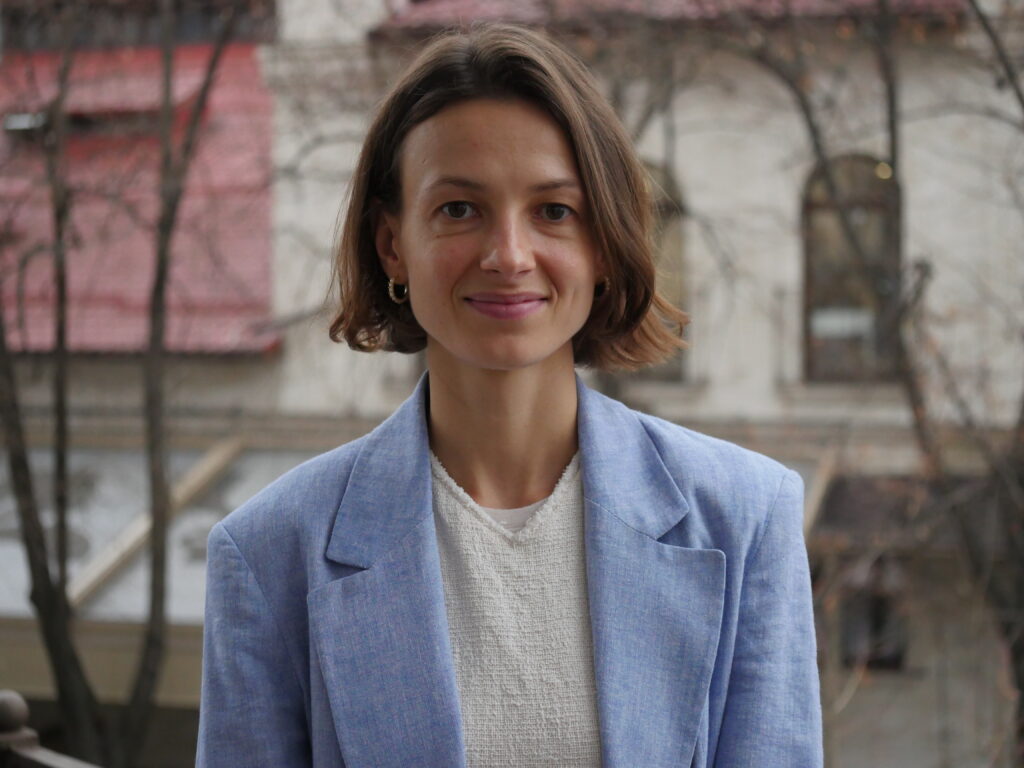Moldova, a small country in Eastern Europe, has fought hard for this momentum, but with every fourth citizen living abroad, is it a lost battle for the nation in the era of global mobility?
Dana Muntean, a Moldovan living in the Netherlands, senses more hope every time she goes back to her homeland — four times just last year. She sees young people challenging the status quo, embracing critical thinking, and wishing to join the European Union.
“There is something special going on in Moldova now, and I feel like whoever returns now can feel like they were part of the big transformation,” Dana says. They would leave a legacy behind, she believes.
Dana isn’t alone in sensing the momentum. Conversations in Moldova’s central park echo sentiments similar to those of Dimitri Malinowski, who now lives in the Netherlands. He’s optimistic about Moldova’s shift toward the European Union. He sees corruption as the main obstacle for his homeland. Dimitri thinks that honest and talented Moldovans abroad could bring the change and replace the old, dishonest mentality.
“There is something special going on in Moldova now,
and I feel like whoever returns now can feel like they
were part of the big transformation.”
Dana Muntean
But is moving back on the table? “There is a slight chance. It’s our country; we are culturally addicted to it. We love the food, wine, people,” says Malinowski, but he is uncertain about it.
Dana would like to return one day, but not permanently. “I think having a husband who’s not originally from your country makes things a bit more difficult because we need to find a formula that works for both of us,” says Dana, who is married to a Portuguese man. But she will carry on contributing from abroad. Her NGO offers global mentorship programs for Moldovans to guide them through challenges.
“I do want to see Moldova as a united nation, embracing its multicultural population and being a hero of our story rather than a victim. I see a prosperous future because I know we are working hard for it,” says Dana Muntean.
No sign of a trend. Yet?
But the demographers seem almost ready to give up on the idea of most of the diaspora ever permanently returning.
“We have lost them,” says Tatiana Tabac, a sociologist and demographer at the Centre for Demographic Research of Moldova. For ten years, she has been focusing on research about the diaspora. This word, “diaspora,” is ingrained in the hearts of every Moldovan, while in many other countries, it’s rarely heard in everyday life.
Tatiana Tabac explains that from 1998 to 2020, over 940,000 people left Moldova.According to World Bank estimates from 2017, there are approximately 1.025 million Moldovan migrants.
“Moldova’s population has decreased by 20–25% due to international migration over the last 30 years,” she says.
There is no indication of a trend towards returning. But primarily due to inadequate data.
“People are not required to declare their departure or return,” Tabac explains. The volume of departures can be estimated based on data from destination countries.
However, the available data suggests that each year, around 1000–2000 returned migrants register as unemployed, primarily pensioners or pre-pensioners. Tabac has noticed the return of — mainly female — migrant workers from Italy. And — mainly male — migrant workers from Russia and Poland, who have reached older age.
Drive to make a change
But there are also some exceptions — young, educated individuals returning with a drive to make a difference.
Elena Druta is one of them. “When I returned, nobody understood why,” she remembers well.
Druta moved to Italy to study political science in 2005. She wanted to study abroad, in a corruption-free university and since her mother was already working there, she joined her. Her father, sister, and her family followed suit, and suddenly, the whole Moldovan family was living in Italy.
“When we left, we initially planned to stay for a certain period, but that planned duration extended longer than expected. However, the idea of returning home never left us,” Druta says.
In 2013, after graduating from university in Parma, she was the first in her family to return to Moldova. It was a much darker place back then. Corrupt politicians stole 1 billion dollars from the banks in the following years. Starting a new life back in her homeland was difficult at first. Besides, returning is also often viewed as a failure among Moldovans, Elena explains.
She spent two more years in Italy and permanently moved back to Moldova in 2018 with her family, being a young mother herself. Her parents followed in 2021.
Last year her sister’s family returned, bringing everyone from Italy back to Moldova. Druta, a political science alumna, is now an advisor to the Moldovan president for the diaspora.
“When I came back, it was very clear to me that I would be an active citizen. I wanted Moldova to be a European country. I wanted Moldova to be a democratic country,” she explains.
Two weeks turned into months
Now, when the diaspora is actually her work field, Druta has discovered that many Moldovans living abroad have limited information about their home country, which hinders their decision to return.
“They don’t know about the good salaries available in Moldova, especially in areas where professionals are needed, like IT and public institutions,” Druta explains.
She still notices many people returning. “I see a lot of good examples in the public institutions and also in the business sector of professionals that come back.”
Natalia Bejan is one example of that. “Moldova is a big enough challenge. We can do so many things differently here, so much to change. This is what excites me,” says Bejan, who first worked as the executive director of the Startup Moldova Foundation but has now moved on to lead the Invest Moldova Agency.
She’s back in Moldova, after living in many different countries, including China and the Czech Republic, consulting companies and corporations.
She first moved to Prague to study. “I was sure that I want to be back when I am finished with my masters,” Bejan acknowledges. She moved back after the COVID pandemic started.

“In Moldova, the rules weren’t so strict. Restaurants were open. In Prague, everything was closed,” she remembers. So, her two-week visit turned into four months. “Then I felt for the first time that I didn’t want to leave. I didn’t want to go back for the first time in years.”
Tatiana Tabac also notices that some Moldovan migrants return home with fresh ideas and skills gained abroad. ”Although relatively rare, there are still remarkable examples of young, active, and enthusiastic migrants returning to Moldova,” sociologist and demographer adds.
They are driven by patriotism or a strong connection to their country.
Serious prediction
But predictions suggest that the population of Moldova will likely decrease even further. Soon, around 2 million people would be living in the country, indicating another half-million decrease.
The Center for Demographic Research made a forecast for Moldova’s population from 2019 to 2040. It shows that it’s necessary to reduce the number of people leaving the country significantly.
In the medium scenario, Moldova’s population is expected to drop to 1.9 million by 2040. However, in the optimistic scenario, the population is estimated to be a little over two million.
Everything depends on whether Moldova continues on a progressive path; the possibility of becoming an appealing home to raise children is not ruled out. Of course, the outcome of the Russian war in Ukraine will play a crucial role in determining Moldova’s future.
Roman Sorocan is one of those who has made peace with never returning permanently to Moldova.
He was only 16 when he first got the opportunity to study in Colorado, USA. After high school, he moved to Bulgaria to study and has visited over 50 countries since. “The key reason I left was my intention to get international exposure and education.”
Sorocan is living in London with his wife, who is also Moldovan, and newborn baby. There is a Moldovan shop not far from their house in London, so they can have a taste of home anytime of the day. “This will be the city I will spend the rest of my life in,” he says.
Can Moldova become a tech hub?
He has had some thoughts of returning. At one point, he really wanted to come back.
“However, since I had my first child, my world has shifted massively, and I think I’ve made my peace with the fact that I will never go back,” he admits. He feels more like a tourist in the country where his parents live.
“The only reason I would go back is for a few years in case there is a massive business opportunity,” says Roman Sorocan who fears that Moldova is still far from his field — artificial intelligence.
“West European cities are the main hubs for advanced tech and have a massive network effect when it comes to my industry. Hence, a lot of people who are in banking, technology, advertising, and other well-paid global roles would not consider going back.”
As his story illustrates, the global trend of professionals seeking opportunities abroad is clear. Therefore, it would be in Moldova’s best interest to position itself as one of those hubs to retain its talent and foster growth. However, accomplishing this is easier said than done.
The four waves of migration
The Centre for Demographic Research of Moldova distinguishes four waves of migration from Moldova.
First wave — ethnic minorities
The first wave of migration occurred in the early years following the attainment of independence and was marked by massive migrations of ethnic minorities. These migratory flows predominantly consisted of migrants of Russian, Ukrainian, Jewish, and German origin, with Russia, Ukraine, Germany, Israel, and the United States being the main destination countries. Ethnic migration spanned from the late ’80s to the mid ’90s. Data shows that between 1989–1995, approximately 176,000 people left the Republic of Moldova. This time interval is notable for the extremely low level of international migration of the native population.
Second wave — first economic migration (Russia and Ukraine)
The second wave of migration began in the mid ’90s, with the emergence of the first migratory flows for work purposes, with Russia and Ukraine becoming the main destinations for migrant workers. At the same time, there were also worker flows to Central and South European countries and to a lesser extent towards Western Europe. This was largely due to the restrictive migration policies adopted by most European Union countries, making migratory flows towards the Russian Federation and the CIS space more pronounced compared to those directed towards EU countries.
Third wave — enforcement of economic migration (EU countries)
Since the early 2000s, a notable increase in migratory flows, a diversification of destination countries, and the formation of the first stocks of Moldovan migrants settled abroad have been observed. A key moment during this period was the legalization of workers who were illegally in Italy, Spain, Portugal, and Greece, and the possibility of family reunification for Moldovan citizens in these countries. In total, between 2000 and 2010, migration from the Republic of Moldova involved a total number of over 400,000 people.
Fourth wave — intensification of migratory flows
Starting in 2010, new trends in migration from the Republic of Moldova have been observed (due to the signing of the Association Agreement between the Republic of Moldova and the EU in the summer of 2014, as well as the intensification of restrictions imposed by the Russian Federation on Moldovan workers).
Available data indicates a decrease in migrant flows to Russia and Southern European countries, such as Italy, Greece, Spain, and Portugal, while there is an observed increase in migrant flows to Western European countries, including Germany, France, and the United Kingdom. The change in international migration trajectories has a reference point in 2014, a moment marked by significant changes both in the internal policy of the Republic of Moldova and in the destination countries’ policies, which has led to an intensification of migratory flows.


Leave a Reply